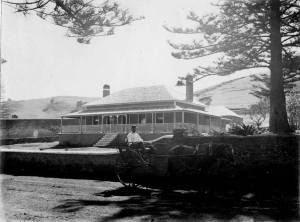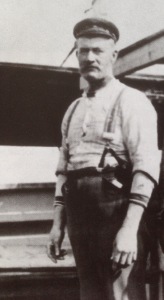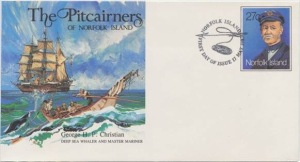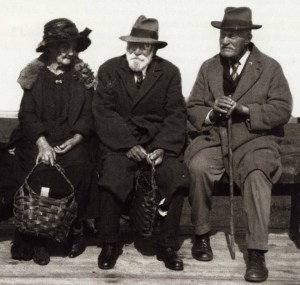 Detail of zoologist Charles Haskins Townsend’s world map compiled in 1931. New Bedford Whaling Museum.
Detail of zoologist Charles Haskins Townsend’s world map compiled in 1931. New Bedford Whaling Museum.It is now exactly twelve months since I joined the Charles W Morgan at Vineyard Haven, on Martha’s Vineyard, Massachusetts in June 2014 to sail to New Bedford, the ship’s home port. Since then through research and writing, I have been pursuing the story of my great-great grandparents on Sunday/Raoul Island and of whalerman, master mariner and Charles W Morgan crew member Parkins Christian. I have also discovered a fascination with the extraordinary (if abhorrent) history of whaling and whales themselves. My research has included visiting museums with whaling-related collections in New Bedford, Massachusetts, Sydney and Eden, NSW, Australia and Lajes da Pico, Pico and Horta, Faial in the Azores. I decided it was time to return to my blog!
Zoologist Charles Haskins Townsend’s world map compiled in 1931 used American whaling records to plot every single recorded whale taken by American ships in the 19th century. Red dots are sperm whales, blue dots baleen whales such as humpbacks and right whales. Sunday or Raoul Island is almost completely obscured by red dots. The Kermadecs lie between the Vasquez and French Rock Whaling Grounds, the red dots stretching from New Zealand in the south to converge and overlap with blue dots to Tonga and almost to Samoa. Another thick line of red dots connects the Kermadecs with Norfolk Island in the west. As a 38th Voyager on the Charles W Morgan in 2014 I had the extraordinary opportunity to actually sail on the only remaining whaling ship of the many that whaled off and visited Sunday-Raoul Island.
Despite the decline of whaling in the Pacific by the time my great great grandparents, the Bells, were living on Sunday Island, American and colonial whaling ships were still hunting whales and provided much needed supplies, equipment and new faces when they anchored off the island. The ships also took on firewood, fresh meat (goats had been left on the islands from the early years of whaling, a fact which undoubtedly saved the Bells from starvation in the first year after they landed) and water although the weather and heavy surf in Denham Bay meant more often than not they couldn’t anchor and go ashore. These visits are recorded in the ships’ logs from the early 19th century.
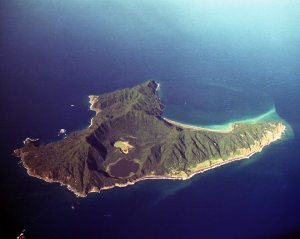 Raoul or Sunday Island – aerial view. The Bells lived first on Denham Bay (the long beach in the south of the island) then moved to North Beach across the ridge. Later they moved back to Denham Bay. http://www.doc.govt.nz/raoulisland.
Raoul or Sunday Island – aerial view. The Bells lived first on Denham Bay (the long beach in the south of the island) then moved to North Beach across the ridge. Later they moved back to Denham Bay. http://www.doc.govt.nz/raoulisland.In December 1878 the California’s log reported that the ship was laying off Sunday Island for three days, sending boats ashore for firewood. In March 1880 the log of the Canton records that “during the day we have very light winds and some times calm. Ship under all sail drifting towards Sunday Island which we saw at 9am”. The California was off Sunday Island again in April 1888 and February 1889. In March 1889 its log reports sighting the Sydney whaler the Costa Rica Packet, whaling off Curtis Rocks.
George Parkins Christian served on several whaling ships including the Sydney-based Costa Rica Packet, the California and the Canton before he joined the Charles W Morgan when she called at Norfolk Island in 1894. Many years later my great-grandmother Bessie remembered his visits and that “it was always the American whalers who were our best friends”. Her father Tom told them the story of the mutiny on the Bounty, of how Christian’s great grandfather Fletcher had fallen out with Captain Bligh. Parkins told them nothing of this but regaled them with stories of the Great White Whale, Moby Dick, “that bit whaleboats in half and crunched them to pieces in his awful jaws”.
From the island the children watched the whales’ annual migration from the Antarctic waters past the Kermadecs to the warmer waters of the tropics and back again with calves in the autumn. Bessie remembered the humpbacks off Denham Bay and the northern shores of the island, and the children watched their antics in delight, fascinated by the fountain-like spouts. Sometimes a whale would leap out of the water, “its huge body vertical between sea and sky and visible for one enthralling second from snout to tail flukes”. She recalled a special moment when, with sisters Hettie and Mary, she witnessed a cow whale feeding her calf. The girls climbed down the cliff to get a better view, looking directly down on the cow rolled on her side ejecting milk directly into the mouth of her twenty-foot long calf.
 Sunday or Raoul Island, the Kermadecs. Bessie and her father and brothers were fishing near Meyer Is. to the north-west of Sunday Island when they were nearly overturned by a humpback whale.
Sunday or Raoul Island, the Kermadecs. Bessie and her father and brothers were fishing near Meyer Is. to the north-west of Sunday Island when they were nearly overturned by a humpback whale.Another encounter with a school of humpbacks during a fishing trip with her father and brothers to nearby Meyer Island was more frightening. The whales appeared from behind the island, broaching and sounding, leaping high and swimming in wide circles around the rowboat, disturbing the hitherto calm waters. When one leapt out of the water and then crashed back down very close to the boat, their father Tom yelled for them to row for their lives. Bessie suddenly realized one was diving under the boat, and felt the bow of the boat heaved up out of the water, then rolled on its side until the gunwale was under the water. The huge shape slid out from underneath and with a violent swirl, turned and flung itself out of the water a few yards away. The flukes towered over the boys’ heads and they threw themselves into the bottom of the boat. Parkins Christian told them later that they were lucky, that when whales swim round and round a boat like that, they mean mischief. The boat could well have been smashed and the occupants “sent down to Davy Jones’ locker – and the sharks”.
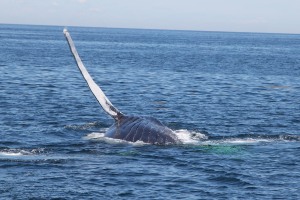 Humpback whale off Massachusetts 2014
Humpback whale off Massachusetts 2014
Fluke of a humpback off the coast of Massachusetts, 2014
One particular whale visitor was definitely not welcome. One morning, outside their hut on Low Flat in the north side of the island, they noticed a terrible smell. The children ran off to the beach to investigate the source and found a decomposing eighty-foot long blue whale “bigger’ the one that swallered Joners … bigger’ the house!” according to little Jack. Tom Bell said it was the largest whale he had ever seen. Faced with living with the stench for months, he commented ruefully that with thousands of miles of ocean all around, the sea had chosen this exact spot to cast up the dead blue whale. The noisome smell wafted on the breeze across the island until at last, thanks to the hot sun, heavy seas and keen winds, the beach was clean and the air pure once again.
Over the past year I have watched humpback and minke whales off the coast of Massachusetts and fin and sperm whales more recently in the Azores, off the island of Pico. It is easy to imagine the Bell children’s awe and delight as they watched these huge and wonderful creatures in the sea all around them.
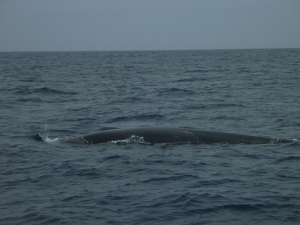 Fin whale off Pico, The Azores May 2015
Fin whale off Pico, The Azores May 2015 Humpback whale off the coast of Massachusetts
Humpback whale off the coast of Massachusetts Minke whale breaching off Plymouth, Massachusetts
Minke whale breaching off Plymouth, MassachusettsMore on Parkins Christian in my next blog.



